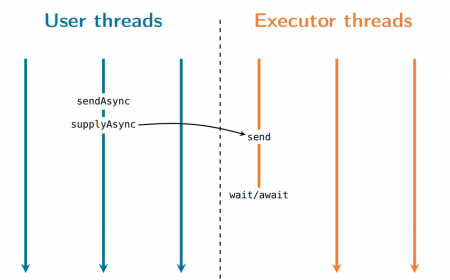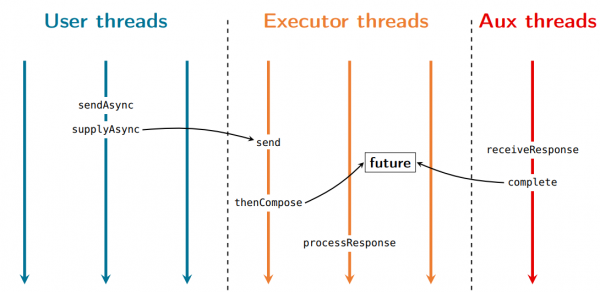CompletableFuture - Avoid blocking inside CompletableFuture chains. It costs.
Problem
如下圖所示,使用ExecutorService最害怕的就是遇到Blocking的操作,這將會降低整個ExecutorService的生產力。

(本篇圖片都來自於link)
How to resolve?
面對這問題,作者建議針對Blocking操作可以在發送後,透過Aux Thread執行;中間透過completableFuture的compose串接;Aux Thread執行完畢後,會將結果丟給串接的completableFuture,並讓工作繼續回到原本的ExecutorService執行。如下圖所示:

我嘗試使用Java8實作,範例程式碼如下:
private static int cpu_num = Runtime.getRuntime().availableProcessors(); private static ExecutorService es = Executors.newFixedThreadPool(cpu_num, CustomThreadFactory.create("cpu_bound_thread_")); public static class BlockingJob { public Response invoke() { try { dumpCurrentThreadName("before blocking job"); Thread.sleep(2*1000); } catch( Exception e ) { e.printStackTrace(); } finally { dumpCurrentThreadName("after blocking job"); } return new Response(); } } private static <T> CompletableFuture<T> launchTaskWithAuxThread(Supplier<T> supplier){ ExecutorService auxEs = Executors.newSingleThreadExecutor(CustomThreadFactory.create("aux_blocking_thread_")); CompletableFuture<T> task = CompletableFuture .supplyAsync(supplier, auxEs); auxEs.shutdown(); return task; } @Test public void testSendAsync(){ CompletableFuture<Response> sendAsync = CompletableFuture.supplyAsync(()->{ dumpCurrentThreadName("supplyAsync"); return launchTaskWithAuxThread(()->new BlockingJob().invoke()); }, es) .thenCompose((CompletableFuture<Response> responseReceived)->{ dumpCurrentThreadName("thenCompose"); return responseReceived; }) .thenApplyAsync((Response x)->{ dumpCurrentThreadName("thenApply"); return x; }, es); sendAsync.join(); }實作特別需要注意的兩個部分是,
- Aux Thread儘量別使用與原本相同的ExecutorService。假如你使用的是固定大小的ExecutorService,可能會造成Deadlock;假如你是使用CachedExecutorService,就必須要注意Thread數量是否會造成OOM。
- thenCompose之後的動作必須使用Async,否則會是用Aux Thread去執行後續操作,無法將CPU bound工作集中。(這部分可能會根據實作會有差異)
輸出如下:
cpu_bound_thread_1: supplyAsync cpu_bound_thread_1: thenCompose aux_blocking_thread_1: before blocking job aux_blocking_thread_1: after blocking job cpu_bound_thread_2: thenApply從結果可以發現,除了blocking的操作外,其餘的操作都是跑在我特定的ExecutorService中。我的想法是,
- 如果此ExecutorService專門用於CPU Bound工作,這做法可分離出Blocking操作避免影響到ThreadPool的生產力。
- 範例中針對Blocking操作是建立單一Thread的ExecutorService,但如果會有IO最大限制的情況下,這部分需要控管數量。
- 這方法雖然有額外的thread context switch,但處於Blocking狀態的Thread並不會與CPU搶資源,因此工作忙碌時所帶來的效能優勢應可掩蓋此缺點。
Note. 我的範例程式只是實現的方法之一,應要根據需求做調整。 例如原始投影片中,是透過responseReceived.completeAsync讓工作回到compose之後繼續往下處理。
Reference
- Java Concurrency In Practice, 11.6. Reducing Context Switch overhead.
